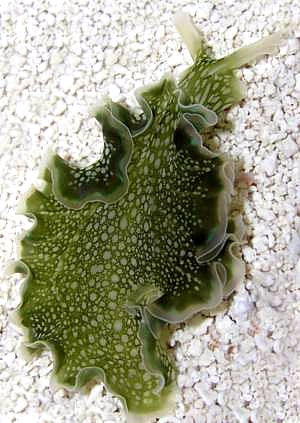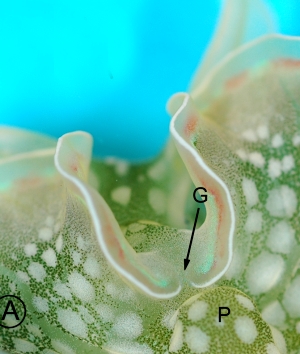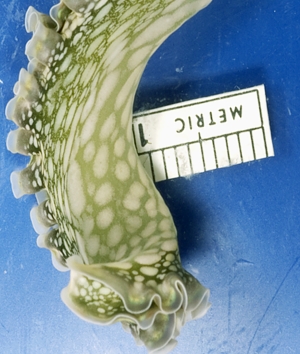
Elysia clarki
Pierce, Curtis, Massey, Bass, Karl & Finney, 2006
Order: SACOGLOSSA
Superfamily: ELYSIOIDEA
Family: Elysiidae
DISTRIBUTION
Commonly found in mangrove swamps, some borrow pits and mooring canals on the Florida Bay side of Long Key, Grassy Key, Crawl Key, Fat Deer Key and Vaca Key, Florida Keys, USA, in depths of 0 – 2.5 m.
PHOTO
Upper: Long Key, (Florida Keys, East coast), Florida, USA. Depth: 5 feet. in Mangrove Canal. Length: Approximately 45 mm in length. 2 June 2005. Photographer: Anne DuPont. Lower photos: Copied with permission from Pierce et al, 2006 to show midline gap between right and left parapodia [left] and colour pattern on sole of foot [right]..
Large elysiid, up to 45 mm long and 30 mm wide with prominent parapodia which are very folded at the edge. The parapodia on each side, almost meet in the dorsal midline, just in front pf the pericardial hump, but there is always a small gap, unlike E. crispata in which the parapodia fuse anteriorly. The body and parapodia are green with many large translucent white circular and ovate spots, which reduce the green areas to a reticulate pattern. The green is caused by the presence of intracellular algal chloroplasts located in cells at terminal ends of the finely branched digestive gland. The translucent white spots have many white and scarce turquoise iridescent pigment cells. This colour pattern occurs over the whole body, including the sole of the foot. The actual edge of the parapodia is translucent clear, and can have three colour bands, a continuous or broken orange band, a continuous green-turquoise band, and a continuous grey-green band -.but any of these can be absent or very reduced in any specimen.
Both E. crispata and E. clarki retain living chloroplasts which continue to photosynthesise within the body of the sea slug, providing it with sugars for its own nutrition. See the page on Solar powered sea slugs for further information. The process of taking chloroplasts from algal cells and keeping them has been given the name kleptoplasty
E. clarki has lecithotrophic larval development [non-feeding planktonic larvae] with veliger larvae metamorphosing into juvenile slugs after about 5 days. Extensive feeding experiments (Curtis et al. 2004) have found the juveniles will eat Bryopsis plumosa and Derbesia tenuissima [but not Caulerpa verticillata as reported by Jensen (1980)]. The length of the life cycle is unknown, but Pierce's lab have raised E. clarki from eggs in the laboratory that are still alive after 22 months and have not yet reproduced.
Molecular and microscopic evidence indicates that adult E. clarki feeds on and sequesters chloroplasts from Penicillus capitatus, P. lamourouxii, Halimeda incrassata and H. monile in the field and will survive for as long as two years in the laboratory on Bryopsis plumosa (Curtis et al. in press).
This species has been confused with Elysia crispata for many years. See separate message [#16728] comparing the two species.
-
Curtis, N. E., Massey, S. E., Schwartz, J. A., Tagihof, H. & Pierce, S. K. (2004) The intracellular, functional chloroplasts in adult Elysia crispata come from several algal species, and are different from those in juvenile slugs. Integrative and Comparative Biology, 44: 686.
-
Jensen, K. (1980) A review of sacoglossan diets, with comparative notes on radular and buccal anatomy. Malacological Review, 13: 55-77.
-
Pierce, S.K., Curtis, N.E., Massey, S.E., Bass, A.L., Karl, S.A. & Finney, C.M. (2006) A morphological and molecular comparison between Elysia crispata and a new species of kleptoplastic sacoglossan sea slug (Gastropoda: Opisthobranchia) from the Florida Keys, USA. Molluscan Research, 26(1): 23-38


Rudman, W.B., 2006 (May 30) Elysia clarki Pierce, Curtis, Massey, Bass, Karl & Finney, 2006. [In] Sea Slug Forum. Australian Museum, Sydney. Available from http://www.seaslugforum.net/factsheet/elysclar
Related messages
-
Relationship of Elysia diomedea and E. crispata
From: Patrick Krug, October 6, 2008 -
Elysia clarki feeding practices
From: Adam D'Agosto, December 6, 2007 -
Elysia clarki and E. crispata in Florida
From: Skip Pierce, October 10, 2007 -
Re: Elysia crispata in Cozumel, Mexico
From: Skip Pierce, February 2, 2007 -
Re: Elysia crispata in Cozumel, Mexico
From: Jim Lyle, February 2, 2007 -
Re: Elysia crispata in Cozumel, Mexico
From: Sean Kearney, February 2, 2007 -
Re: Elysia crispata in Cozumel, Mexico
From: Skip Pierce, February 1, 2007 -
Elysia crispata in Cozumel, Mexico
From: Sean Kearney, January 29, 2007 -
Elysia clarki feeding references
From: Nicholas Curtis, January 29, 2007 -
Re: What's wrong with Elysia clarki?
From: Colin Redfern, September 9, 2006 -
Re: What's wrong with Elysia clarki?
From: Colin Redfern, September 9, 2006 -
Re: What's wrong with Elysia clarki?
From: Skip Pierce, September 8, 2006 -
Re: What's wrong with Elysia clarki?
From: Angel Valdes, September 7, 2006 -
Re: What's wrong with Elysia clarki?
From: Skip Pierce, September 1, 2006 -
Re: Damaged Elysia crispata
From: Nick Curtis, August 31, 2006 -
What's wrong with Elysia clarki?
From: Bill Rudman, August 30, 2006 -
Elysia diomedea & E. clarki in home aquarium?
From: Matt Pedersen, May 30, 2006 -
Elysia clarki breeding in the home aquarium
From: Matt Pedersen, May 30, 2006 -
Elysia clarki, E. diomedea and E. crispata
From: Bill Rudman, May 30, 2006 -
A new Elysia from Florida
From: Bill Rudman, May 30, 2006 -
Lettuce Sea Slug behavior and feeding
From: Patrick Glenn, April 13, 2006 -
What to feed Elysia crispata?
From: Alexandra Ahnide, April 11, 2006 -
Elysia crispata feeding and babies
From: Willem Bermel, January 31, 2006 -
Re: Colour in Elysia (again)
From: Anne DuPont, November 7, 2005 -
Re: Lettuce sea slug - breeding success
From: Vincent, June 27, 2003 -
Lettuce sea slug - breeding success
From: Rick Hahn, May 31, 2003 -
Re: Gene transfer - Elysia crispata
From: Skip Pierce, May 5, 2003 -
Re: Algal genes in Elysia crispata
From: Philip Cromwell, May 3, 2003 -
Re: Elysia crispata and algal genes
From: Skip Pierce, May 3, 2003 -
Algal genes in Elysia crispata
From: Skip Pierce, May 2, 2003 -
Elysia crispata babies
From: Joe Bongiorno, December 30, 2002 -
Re: Baby slugs!
From: Joe Bongiorno, December 18, 2002 -
Re: Baby slugs!
From: Joe Bongiorno, December 10, 2002 -
Bifid rhinophores in Elysia crispata
From: Anna L. Bass, September 12, 2002 -
Elysia crispata? in aquaria
From: Ash, April 1, 2002 -
Re: Baby slugs! - Elysia crispata
From: Jeff Zimmerman, June 4, 2001 -
Re: Baby slugs! - Elysia crispata
From: Jeff Zimmerman, March 22, 2001 -
Baby slugs!
From: Jeff Zimmerman, March 17, 2001
